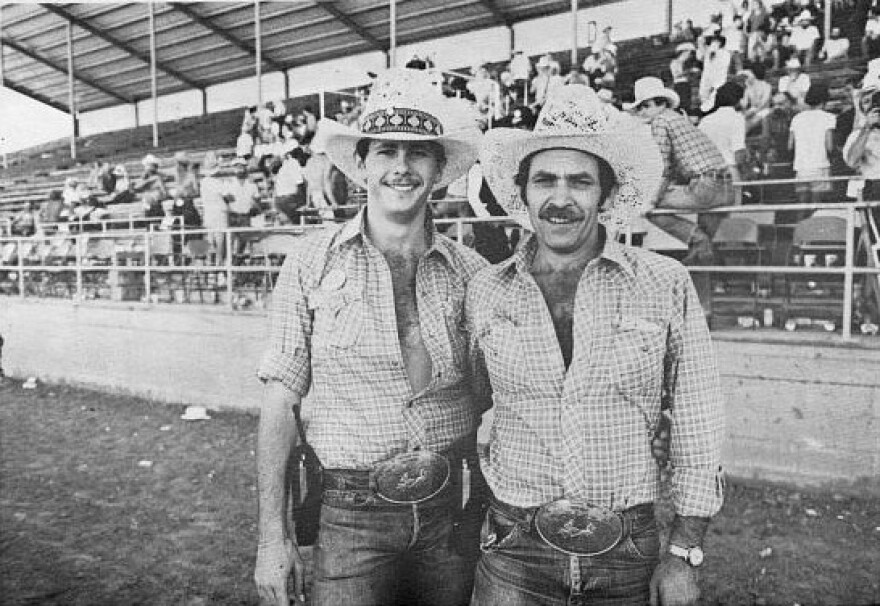1983 was a tough year for Reno’s LGBTQ+ community.
The AIDS epidemic had reached Nevada, according to the Nevada Division of Public and Behavioral Health. And the Gay Rodeo was facing a stronger threat of violence than in years past. An article from the Reno Evening Gazette said that anonymous telephone calls to Reno’s three main television stations warned that snipers were poised to shoot attendees.
Despite threats on multiple fronts, the event was one of the few times that being openly gay was generally accepted in the Biggest Little City.
Tracey Lake first began attending in the late 1970s.
“As a teenager, I’m just… I’m 17, 18 years old,” Lake said. “I’m just figuring out that I like girls.”

She grew up in Miami and moved to Reno around this age. Miami, in her experience, wasn’t as welcoming to her. Reno’s Gay Rodeo was one of the first public LGBTQ+ events she attended.
“It was validating,” Lake said. “Strong, good-looking guys holding hands and kissing, wearing tight jeans with these different colored bandanas in their pockets. I knew it wasn’t my tribe entirely, but I was part of the community for being gay.”

Gay Rodeo founder Phil Ragsdale wanted to create a space for the LGBTQ+ community to express themselves openly, in a way that countered stereotypes of gay men.
Ray Martin was a friend of Ragsdale and helped organize the rodeo for several years. He said nothing like it had existed before.
“It helped a lot of regular, supposedly straight rodeo people do something with other people that were like them. They could actually be themselves,” Martin said. “And there were champions that came that rode horses without repercussion.”
Martin said the rodeo included mostly gay men but also lesbians and drag queens.

‘Transgender’ or ‘genderqueer’ weren’t words commonly used in the LGBTQ+ community at the time, but there were likely trans and gender-nonconforming people there too, who publicly identified as ‘drag queens or kings.’
As the gathering grew bigger, protests began to pop up in the event parking lot, both in opposition to homosexuality in general and also to oppose the mistreatment of animals.
“We just ignored them. We didn’t confront them. We didn’t argue with them. We didn’t counterprotest. We just simply ignored them,” Martin said.
In 1982, the event was at its height. With around 20,000 people at the event, led by Joan Rivers, the grand marshal.
But then, it hit Nevada. The AIDS crisis spread to many cities across the country in waves, including Reno. And partly because of that, the gay rodeo in Reno disappeared.

“We were all friends. We all cared for each other. And they were just going, going, going, going,” Martin said. “And pretty soon, there wasn’t anybody left.”
Martin was devastated when he lost his friend, Rodeo founder Phil Ragsdale. He died of AIDS in 1992.
Martin said the only reason he and his husband survived was because they were monogamous.
“The lesbians took care of the gay guys that were dying,” Martin said. “Because there wasn’t enough of us to take care of them.”
Tracey Lake, who first attended the rodeos as a teen, would help out when she could.

“It did give me a sense of what good community felt like. And I’ve strived to create community every place I’ve gone,” Lake said. “And I think, in part, because of how the community rallied in crisis. And they rallied in love. But they absolutely rallied in crisis.”
The Gay Rodeo in Reno began to resurge in the mid-2000s, but it too lost momentum. However, gay rodeos still take place annually in other parts of the country, including in Las Vegas.
Editor's Note: We'd like to extend special thanks to Jeff Auer, a local LGBTQ historian and University of Nevada, Reno Humanities Instructor who aided in research in this story.
Editor’s Note in May of 2020: For additional context on the cancellation of the Reno Gay Rodeo in 1985, Paco Lachoy, rodeo attendee and veteran LGBTQ+ journalist with The Reno Gay Page, said that financial issues were a significant reason why the rodeo ended.








